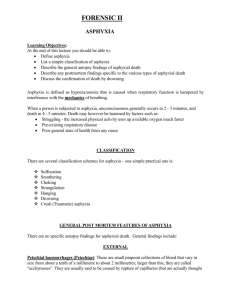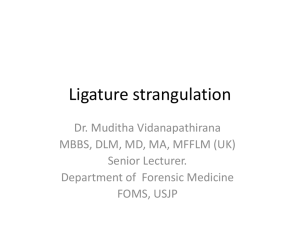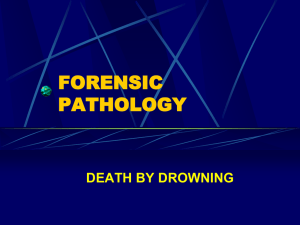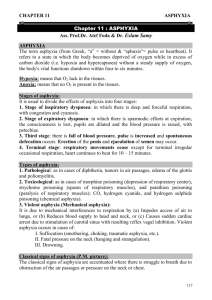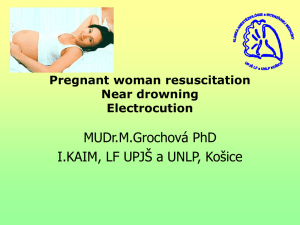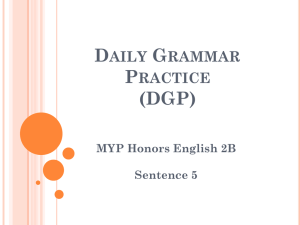ASPHYXIA
advertisement
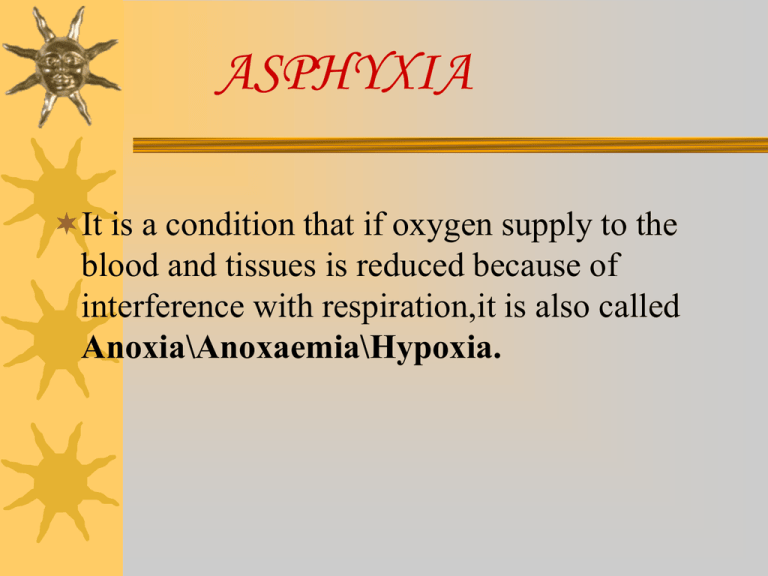
ASPHYXIA It is a condition that if oxygen supply to the blood and tissues is reduced because of interference with respiration,it is also called Anoxia\Anoxaemia\Hypoxia. Causes of asphyxia Obstruction to the air passages due to hanging,strangulation or throttling. Causes of external respiratory orifices,as in smothering. Occlusion of the air passages within as in drowning or laryngeal spasm. Pressure on the chest,as in traumatic asphyxia Inhalation of irrespirable gases like carbon monoxide. Spasm of the respiratory muscles,as in strychnine poisoning. Paralysis of the respiratory center,as by narcotics and anesthetics. Obstruction to the upper respiratory passage in cases of angioneurotic oedema. Features of asphyxia Cyanosis,capillary dilatation,capillary stasis,rise of capillary pressure. Increased capillary permeability,Tardieu’s spots and relaxation of sphincters. Asphyxia Reduction in o2 tension Deficient oxygenation in lungs Capillary dilatation Reduced pulmonary flow Capillary stasis Diminished venous return to heart Capillary engorgement Stasis of blood in organs Mechanical asphyxial deaths or Violent asphyxial deaths Hanging Strangulation Suffocation drowning Hanging Hanging is a form of asphyxial death which is caused by the suspension of the body by ligature which encircles the neck,the constricting force being the weight of the body. Types Complete hanging. Partial hanging. Typical hanging. Atypical hanging. Complete hanging When feet do not touch the ground and the weight of the body acts as a constricting force. Partial hanging When the weight of the head and not the whole body acts as a constricting force is known as partial hanging. Typical hanging The ligature is situated in the midline above the thyroid cartilage and runs symmetrically upwards on both sides of the neck to the occipital region. Atypical hanging Any variation of this standard position. Ligature Not particular,like ropes,chains,wire,leather straps,belts,scarf,dhoti,sarees etc. Its important to match the ligature with the ligature mark and see if its strong enough to bear the weight and jerk of the body. Cut the ligature away from the knot. Symptoms So rapid that they are rarely observed. Flashes of lights before the eyes,ringing in the ears. Unconsciousness and death. The individual can do nothing to help himself even if it were possible. Respiration stops before the heart which may continue for 10-15min. Causes of death Asphyxia Ligature forces the tongue up and occludes air,15kg tension occludes the trachea. Cerebral congestion Obstruction of jugular veins by compression with 2kg wt tension. Cerebral anoxia Carotid artery occludes with 4-5kgs tension and vertebral artery with 20kgs tension. Reflex vagal inhibition. Fracture dislocation of cervical spine t the level of 2,3,and 4 vertebrae. Combination of any of the above. Postmortem appearance External appearance. Internal appearance. External appearance -Above the ligature. -Beneath the ligature. -Below the ligature. Above the ligature mark Tilt of the head. Protrusion of tongue. Dribbling of saliva. Le Facia Sympathique. Tardieu spots. Congestion of the face. Petecheal haemorrhages. Middle ear haemorrhages. Beneath the ligature Fixed or running noose. Position of the knot. Course of the ligature. Width and multiplicity. Point of suspension. Slipping of ligature. Weight of the body. Below the ligature Postmortem lividity (Glove and Stocking) Relaxation of sphincters. Injury to legs.(partial hanging) Internal appearance Haemorrhages in the neck. Dry,white and glistening. Rupture of platysma and sternomastoid. Transverse tear in the intima of carotid artery. Fracture of hyoid,cricoid and thyroid cartilages. Congestion of organs. Petechial haemorrhages. Diagnosis Ligature mark around the neck. Presence of abrasions,echymosis and redness around the ligature mark. Trickling saliva from the mouth. Echymosis of larynx and trachea. Rupture of intima of carotids. Signs of asphyxia. Medico-Legal Aspects Was the death due to hanging? Whether hanging was suicidal,homicidal or accidental? Typical oblique,non-continuous,high up ligature mark. Abrasions and echymosis above and below the ligature mark. Extravasation-tear of the intima of the carotids. Saliva and signs of asphyxia. Suicidal Usually full suspension. Ligature tied to beam,hook,fan,tree etc. Suspension without any platform is unusual in suicide. Occasional nail mark-may be self inflicted while trying to free him\herself. Suicidal note. Homicidal Extremely rare,except in case of lynching. Difficult,unless the victim is unconscious by injury or by drugs. Marks of violence may be seen on the body. Postmortem hanging\Suspension Person murdered and the dead body suspended to simulate suicide. Usually the rope is tied first to the neck and then around the beam\hook where beam shows evidence of rope being pulled from below upwards. Ligature mark may be produced if the body is suspended within 2hrs after death. Judicial hanging Drop of 5-7meters. Fracture dislocation at cervical 2-3 or 3-4. Transection of spinal cord. Tear of intima of carotid artery. Injury to pons and medulla Strangulation It’s a form of asphyxial death caused by the constriction of neck by ligature or by any means without suspending the body. By ligature. Manual strangulation Or Throttling. Causes of death Asphyxia Anoxia Congestion Vagal inhibition Combination of any of the above Autopsy finding Externally-usually those of asphyxia. Ligature mark Well defined,slightly depressed at any level on the neck-usually at the level of thyroid cartilage or below. Encircles the neck transversely-more prominently at the front than the sides. It may be interrupted by clothing or victims finger or ornaments. May be oblique if the victim is sitting and assailant is standing. Fold marks on neck Seen in infants and children with short neck. Tight collar may produce a mark similar. Examination of ligature-for blood,fragments of epidermis,hair or other substances. Sign of struggle. Internal Laceration of muscles. Hyoid bone fracture usually not seen. Fracture thyroid is more common. Fracture of cricoid is rare,but if pressure is used may be seen. Organs are congested. Medico-Legal aspects Suicide Its rare but possible.cord may be used and twisted with a stick. Congestion is very prominent because of slow obstruction. Homicide Common form of murder-associated with sexual offences. Infanticide-by strangulation with umbilical cord. Evidence of struggle,surprise attack,under intoxication,weak personality. Common methods of Homicidal strangulation Throttling Compression of neck by hands. Bruises produced by tips of fingers. More force is used than is necessary. Marks of thumb on one side and fingers on other side. Pressure of nails produce cresentic marks with or without incision,concavities follow anatomical shape of the nail margin and nails with straight border give unpredictable results. Hyoid bone fracture and bruising can be seen with careful neck dissection. Bansdola Practiced in north India. Bamboo or sticks are used. Garrotting Victim is attacked from behind without warning,ligature thrown round the neck and tightened. Mugging Strangulation by holding the neck in the bend of the elbow/knee. Accidental strangulation Children may get entangled during play. Infants are strangled in their cots,when the neck is caught in sidebars. Alcoholics,epileptics and insane persons are susceptible for accidental strangulation. Suffocation It’s a form of asphyxia caused by mechanical obstruction to air passage due to causes other than constriction of the neck. Smothering It’s a form of asphyxia caused by closure of external respiratory passage either by hand or other means,or introduction of foreign materials like cloth or paper etc. Medico-Legal importance Suicide Not possible by hands. Possible by means of tying polythene bag over the head/burring the face in mattress. Creating suffocation in the closed and nonventilated rooms. Homicidal Possible when victim is incapacitated by drugs/alcohol,can be smothered. Accidental Infants/children by weight of clothes etc. While playing with plastic bags. In adults-plastic bags for auto erotic exercise as partial anoxia enhances sexual sensation. Mothers-during breast feeding. Postmortem findings. Asphyxial signs. Abrasions & bruises around the lips and cheeks. Injuries on inner side of lips. Gagging It results from closure of mouth by a cloth or similar material causing obstruction to the larynx or force the base of the tongue against the fauces. Overlying Compression of chest to prevent breathing. Mother infants. Forceful pressure over the chest. Burking Method of homicidal smothering. Practiced by “Burk” and “Hare” Chocking Caused by obstruction within air passage. Usually accidental. From diseases-Diphtheria,laryngeal spasm,infection etc. Hyoid bone fracture Inward fracture. Antero-posterior fracture. Avulsion fracture. Inward fracture Seen in throttling-main force is an inward compression on the hyoid bone. Fingers squeeze the greater horns towards each other,due to which the bone may be fractured and post fragments displaced inwards. Antero-posterior compression fracture In case of hanging,the hyoid bone is forced directly backwards due to which,the divergence of greater horns is increased which may fracture with outward displacement of the posterior small fragments. Ligature strangulation,run over accidents. Avulsion fracture Very rare and is due to over activity of neck muscles without direct action or injury to hyoid bone. IncidenceHanging 15-20% above 40yrs age. Very common in throttling. Diagnosis of throttling Cutaneous bruising and abrasions. Extensive bruising with/without rupture of neck muscles. Engorgement at/above the constriction. Fracture of larynx,thyroid cartilage and hyoid bone. Cricoid I almost exclusively fractured in case of throttling. Asphyxial signs. Chocking Obstruction within the air passages. Accidental inhalation of food when the victim is laughing or crying. Vomited material may be inhaled by a person under the influence of drink or anesthetic drug. Large food bolus,piece of meet seeds or fish,teeth(loose),marbles in children. From diseases-diphtheria,laryngeal edema,bronchial growths.Hemorrhages. Causes of death Asphyxia,vagal inhibition,laryngeal spasm,infection. Café coronary Impaction of food in the sensitive larynx causes sudden death due to cardiac arrest. Healthy intoxicated person in hotel while eating suddenly turns blue,coughs violently-collapses and dies. At autopsy a large food bolus seen in the respiratory tract-larynx obstructing air passage. Signs of chocking are absent because of high blood alcohol which inhibits the gag reflex. Post-mortem appearance-the foreign body is embedded in a thick mucus in the trachea. Traumatic asphyxia Its due to respiratory arrest due to mechanical fixation of chest so that the respiratory movements are prevented. E.g.:Stampede in a theatre or in places where crowded gatherings are there.Fall of earth-coal mines,tunneling accidents etc. Post-mortem appearances An intense deep purple red colour of the head,neck and upper part of chest above the level of constriction. Sexual asphyxias Partial asphyxia causes cerebral disturbances with feeling of sexual gratification. Pressure on carotids/trachea leads to hallucinations of an erotic nature. Associated with masochism and transvestitism. Usually can be seen in young males. Place-victims own house-bed/bath room. Padding of neck. Ligature,a running noose,the free end of which is tied to limb,weight of the body is used to control the ligature. Naked,pornographic literature etc. Its due to retrograde displacement of blood from superior venacava into subclavian veins of the head and neck due to sudden compression of the chest blood does not enter the upper limbs due to the valves. Blood goes into the valve less veins of the head & neck causing stasis and engorgement of the vessels and rupture of the distal venules and capillaries causing petecheal hemorrhages. If patient survives-purple colour gradually disappears within 14-15 days. Drowning Drowning is a form of asphyxial death due to aspiration of fluid into the air passages by submersion of the body in water or fluid medium. Complete submersion not necessary,submersion of nose and mouth is enough. Classification Typical Atypical Typical drowning Obstruction of air passages and lungs by inhalation of fluid and is known as “Wet drowning”. Typical signs are found at autopsy. Atypical drowning Conditions in which there is very little or no inhalation of water or fluid in the air passages. Dry drowning. Immersion syndrome(vagal inhibition). Submersion of the unconscious. Secondary drowning syndrome/neardrowning. Typical drowning Fresh water drowning. Salt water drowning. Fresh water drowning Water cross the alveolar membrane into the circulation. Produces marked hypervolaemia. Red cells swell or burst-hemolysis-liberation of potassium. Circulation will suffer 50% dilution within 2-3 min. The heart is submitted to the insult of anoxia,hypervolaemia,potassium excess and sodium deficit. Ventricular fibrillation due to anoxia and potassium excess within 4-5 min. Salt water drowning Marked hypertonicity of the inhaled water cause loss of fluid from circulation into the lungsfulminating pulmonary edema and progressive hypovolaemia. Circulatory shock and cardiac arrest. Atypical drowning Dry drowning Intense laryngeal spasm due to entry of water into nasopharynx and larynx. Very little water enters into lungs. Best case for resuscitation. Immersion syndrome Due to sudden impact with very cold water and causes death from cardiac arrest. Victims are young people with excess of alcohol. It also result from falling or diving with feet or duck diving by the inexperienced swimmers. Loss of consciousness instantaneous and death occurs in few minutes. Autopsy disclose non of the usual signs of drowning. Submersion of the unconscious Commonly seen if the victim is suffering from disease like epilepsy,heart diseases and is drunk or head injury during fall. Ballooning of the lungs may be absent. Formation of the foam my be negligible. Complete picture of death by drowning is not found. Secondary drowning/near-drowning Its mainly due to infection from inhalation of contaminated water. Lung complications,oxygen lack,tired heart muscle and cerebral edema. A victim look alert and breathing,may respond to initial resuscitation. Late stage-respiratory distress,hypotension and cardiac arrhythmia may cause death. Vicious cycle of drowning Deep inspiration Need for air Water enters resp.passage Air driven out of lungs Cough reflex Medico legal aspects Whether the death was due to drowning or other cause? Length of time the body was in water. Whether it was accidental/suicidal/homicide? “Brides of the bath case” Postmortem findings External findings Fine froth at the nose and mouth.its white or rarely blood stained,leather-like,abundant and increases in amount with compression of the chest. Rarely the presence of weeds,mud etc in the tightly clinched hand. Cutis anserina(Goose skin) Due to spasm of the erector pilae muscles and due to exposure to cold water at the time of death. Rarely seen in India. Skin appears granular and puckered,with hair standing on the end. Extremities are mainly affected. The skin of the finger,palms and later the soles of the feet may be wrinkled,bleached and sodden. Due to osmotic action of water,on thickened epidermis. This immersion changes known as Hands and Feet of a Washer-Woman. Internal findings Lungs & respiratory tract:Airways filled with froth,sand,weeds etc found in the water. Lungs are voluminous,edematous,doughy to feel with rib markings. Paltauf’ hemorrhages seen. C/s:- Oozing out of blood stained frothy fluid and ballooning of the lungs is known as “Emphysema Aquosum”. Wt upto 2 kgs. Watery fluid transudates into pleural cavities during putrefaction. Hydrostatic lung:- 2meters depth-20min. Hemorrhages in the middle ear & mastoid air cells. Water in the stomach & intestine. Biochemical changes “Getlers test” Chloride content in chambers of the heart normally 600mg/100ml. Chloride decreases by 50% in fresh water & increases of 40% in salt water. Test is of doubtful value in -Septal defects -Putrefaction -Death due to vagal inhibition -Chloride in water Diatoms Microscopic unicellular algae present in water. Silicaceous cell wall which resists acid digestion,heat and putrefaction. Size 10-80 microns. Only a live body with a circulation can transport diatoms from lungs to the brain or bone marrow. Isolation- acid digestion of tissue commonly bone marrow,lung,blood and kidney-centrifugation and washing.residue is examined under phase contrast microscopy. Cause of death Asphyxia Ventricular fibrillation Laryngeal spasm. Vagal inhibition. Exhaustion. Injuries. Fatal period 4-8min. Diagnosis of drowning Froth Weeds & gravel/soil in hand. Voluminous lungs. Diatoms in tissues.
